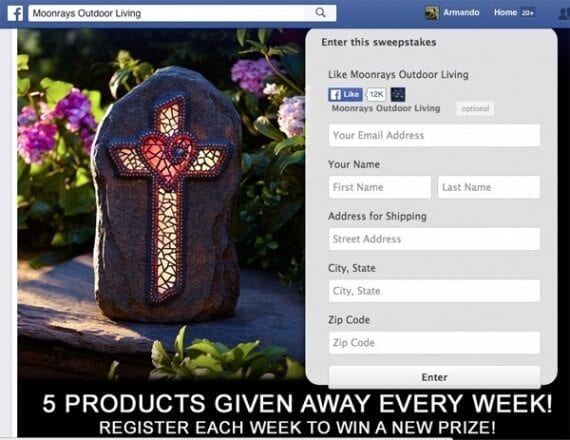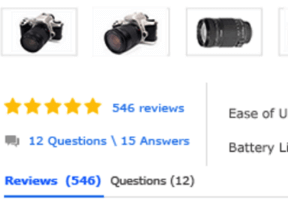
Contests can build awareness and help grow lists for future marketing. Moonray’s, a seller of landscape accessories, runs sweepstakes on Facebook. Folks simply enter for a chance to win.
A well run online contest can bolster your social media following, energize loyal customers, collect information about the folks who enter, and help build lists for further marketing.
Contest marketing uses contests (wherein entrants compete against each other) and sweepstakes (wherein winners are drawn) to (a) attract possible customers, (b) collect information about those potential customers, and (c) earn the right to market to prospective customers after the contest or sweepstakes.
Social media and a number of contest apps make it relatively easy for marketers to set up and run an online contest. But to do the job of contest marketing properly, you’ll need to do a bit of planning.
Step 1: Have a Goal, Aim, Purpose, or Reason
Like every good marketing tactic, marketing contests need to serve a purpose. They should be a means to an end, a way of achieving some goal.
For example, when a prize is at stake, prospective customers will often share more information with a business than that same customer would in other circumstances. So contest marketing is particularly good if the aim is to collect information or to get someone to like or follow a social media account.

One retailer’s contest-marketing campaigns were meant to get new email subscribers. The contest, via Woobox, earned about 1,000 new email recipients for every 5,000 folks who entered. The retailer used its own existing email list to promote the contests, which could explain the ratios.
For example, a retailer in the northwestern United States ran more than 40 online contests last year with the aim of acquiring new email subscribers. As part of the terms of the sweepstakes, everyone who entered subscribed to the company’s email marketing. A sweepstakes with 5,000 entries might include 4,000 loyal customers and 1,000 new prospects who were now registered to receive email marketing.
Step 2: Plan Your Contest
In this article, I’ve used the term “contest” to described online giveaways and contests generally, but there really are different sorts of contest marketing. And the type of “contest,” in the general sense, should vary depending on your goals.
More strictly defined, contests are a game of skill or an actual competition between contestants. For example, an online retailer asks customers to post photos of themselves with the store’s products. The best photo or the photo with the most votes wins.
Sweepstakes are a game of chance. Folks simply enter for a chance at a drawing. Knowing which sort of contest will help you achieve your goal is the first part of planning.
You will also need to decide:
- When the contest will run;
- What information will be collected;
- How the entrant will actually enter the contest;
- Which platforms (i.e., Facebook, Pinterest, your website) will be used;
- How the contest will end.
Step 3: Terms and Rules
You will need to develop a set of terms, conditions, and rules for your contest or sweepstakes.
Your contest marketing campaign’s rules should serve three purposes.
- Ensuring that your contest or sweepstakes complies with legal requirements.
- Make certain that entrants understand how their information will be used.
- Establish a framework for a fair selection and a clear winner.
A good set of rules can help to avoid problems.
In 2009, a brick-and-mortar retailer was celebrating its 50th year in business. The company had special events at several of its stores.
At one of these events, the store gave away a new Ford F-150 truck valued at more than $30,000. According to the terms of the sweepstakes, entrants did not need to be present to win and, other than being older than 18, there were no restrictions.
Unfortunately for the store, which hoped the truck would go to a local customer, the winner was someone who lived more than 600 miles away, who just happened to be driving through town. A rule about residency could have produced a different outcome.
Step 4: Promote Your Content
Once you have goals and a plan, prepare to promote your contest. A common approach would be to use a combination of email marketing, paid social media advertising (think ads on Facebook), digital advertising, and even traditional media.
As is almost always the case in marketing, the promotions you select will vary based on your budget and goals. Remember that how you promote your content marketing campaign will have a significant impact on your results.
For example, one retailer ran the same sweepstakes twice in 2015. In both cases, folks were entering to win one of 10 pairs of Dansko shoes worth, perhaps, $135 each.

In each of the sweepstakes, folks entered for a chance to win one of 10 pairs of Dansko shoes.
The sweepstakes first ran in April 2015. It was promoted on Facebook and with an email to a small portion of the retailer’s email list. This first instance generated about 4,000 entries.

The first time this sweepstakes ran, it generated about 4,000 entries.
The sweepstakes ran again in August 2015. This time it was also promoted on Pandora and on radio in select markets. In the second attempt, more than 11,000 folks signed up.

Adding radio and Pandora advertising to the promotional mix nearly tripled the number of entries.
Step 5: Select the Contest Winners
It may seem obvious, but you need to select the winners in accordance with the rules you set up. As much as possible, try to remove yourself from the selection process. Many contest-marketing apps will have an automated way to select the winners.
Step 6: Let Folks Know Who Won
Once the winner or winners have been chosen, let everyone know.
Consider sending an email to everyone who entered the contest. Thank them for entering. Tell them who won. Offer them a coupon code good for their next purchase in your store.
Separately, post the winner’s name to whatever platform you used for the contest. If you used Facebook, post the winner’s information on Facebook. If you ran the contest on your own website, post the winner’s information on the contest landing page.
Step 7: Measure the Contest’s Effectiveness
Although the contest or sweepstakes is over and the winner selected, your work is not quite done. Look at the results and determine if the content marketing campaign was a success.
Did you hit your goals? Can you do better next time?




